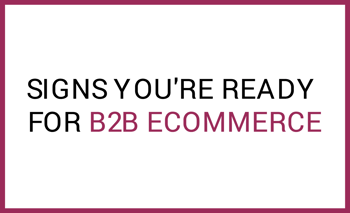
 Tips for Planning your B2B Commerce Site
Tips for Planning your B2B Commerce SiteAs more and more customers prioritize customer experience, B2B organizations are realizing the importance of embracing eCommerce. According to a recent whitepaper by Magento, 93% of B2B buyers prefer to purchase online, and 46% of companies who recently migrated offline customers online expect 50% or more of their customers to be buying online within three years.
If your organization isn’t yet utilizing B2B eCommerce, it’s time to take a look at your business and see if you’re ready to take that leap. But how will you know for sure? Magento has identified a few signs that your organization is ready to undertake a B2B eCommerce project.
Magento Senior Marketing Manager Shannon Hane identified a number of common drivers for launching a B2B eCommerce implementation, including the following:
"Competitive pressure: A local – or, increasingly, national or even global – competitor that has invested heavily in eCommerce capabilities begins siphoning away business and customers.
Customer demand: In many cases, B2B customers express an interest for a more convenient way to purchase products or services. As is the case across all industries, most B2B customers have been delighted by the speed, ease, and service they experience while buying from leading B2C companies. These experiences greatly increase their expectations concerning other types of transactions, including B2B purchases.
Internal goals and constraints: Many B2B companies invest in eCommerce as a means of reaching new customers as they strive to meet growth targets. Other organizations turn to eCommerce as a way to conduct sales (and service) more efficiently in the face of resource constraints.
Aging 1.0 eCommerce technology: B2B companies that set up homegrown eCommerce systems or invested in early-generation technology years ago often reach a point where: 1) those applications no longer satisfy customer needs; and/or 2) the upgrades, customizations, and ongoing maintenance of those applications becomes more costly than investing in a state-of-the-art system."
If any of these signals applies to you, then it’s time to get started. But where do you begin? Here are our first steps to kicking off a B2B eCommerce project.
The first thing you need for a successful B2B site is a project champion. A B2B eCommerce project will touch almost every part of the organization: sales and marketing, operations, finance, and, especially, IT. There needs to be a champion for the B2B site within the organization to drive the project forward. This designated project leader will ensure that the platform is nurtured and continues to grow once it has been launched.
The role of project leader and, eventually, B2B eCommerce champion, requires someone experienced in conventional sales strategies as well as digital tools, social marketing strategies, and leveraging those skills in a B2B environment. No one can do this job successfully without a background in technology and, ideally, marketing communications and marketing technology.
Some of these key traits will depend on your goals for the Magento B2B site. Is this site going to be an automated inside sales rep? If that’s the case, you’ll want someone who is focused on efficiency and operations. If you’re using your Magento B2B site to grow new business, you’ll want the candidate to be marketing focused.
Perhaps most importantly, an eCommerce Manager must be an effective leader who can create relationships with other departments in your organization. Throughout the implementation and post-launch, the project team will need support from marketing, sales, finance, operations, and especially IT. Your eCommerce Manager should be a savvy negotiator who can garner support from the other departments, which will ensure the success of both the initial implementation and the entire B2B eCommerce initiative.
As our team is fond of saying, “There can only be one number one priority.” If your team does not have someone whose number one priority is the site, then no one’s number one priority is the site. Without constant attention and dedication, your B2B eCommerce site will fail.
Before we get too far in your planning, let’s take a look at why you’re building this Magento B2B site in the first place. Identifying your priorities is a crucial step and will help keep things on track as development advances. We typically see the following three goals when our clients are identifying their priorities:
While each of these three things is important, one has to be the number one priority. This will help you focus your project. For example, if your main objective is to increase revenue, you’ll want to hone in on the marketing capabilities and campaigns of your new site. If you wanted to decrease costs, then automation through integration with your back-end system will be the project focus. And, if customer satisfaction is your top priority, then the user interface and customer experience will be of the utmost importance.
Again, all of these are important, but you’ll need to pick one as the top priority. Most B2B clients we work with focus on decreasing costs through integration and automation.
So, when it comes to identifying your priorities for your B2B eCommerce site, keep in mind what will make the user experience more enjoyable for your customers and/or sales team.
How can you ensure that your B2B eCommerce site will come out well? How will you know if the finished product was worth all of this time and effort? First, you need to define your success metrics.
More often than not, your success metrics will be solid numbers and statistics that you can measure and identify once your site is live.
Success metrics (we’re talking numbers) need to be based on the “why” behind your implementation. If your site’s purpose is to increase revenue or decrease costs, then your success metrics will be measured in dollars. If customer experience is the goal, then maybe your metrics are something like fewer calls into a call center, or a shorter wait time to speak with a CSR.
One big goal we look at for B2B projects is rate of adoption. But how do you determine what those metrics are? Things like average order value, customer lifetime value, and the ability to cross- and upsell customers will help you determine your success metrics there.
Don’t forget to look ahead when determining your success metrics. Sure, the first few quarters will be important, but don’t be afraid to set success metrics for one, three, or even five years out.
With a Project Champion assigned, goals identified, and success metrics determined, it’s time to fully understand how you’re going to attract customers to this new site.
The good news is that establishing a solid platform to drive traffic to your B2B site is the first step in your marketing strategy. With your new site underway, your marketing efforts are off to a great start.
Much like the rest of this project, effective B2B marketing leans on tactics from B2C. We follow four components of B2B eCommerce marketing: driving traffic, making conversions, increasing the average order value, and developing customer lifetime value.
Driving traffic is all about getting people to a site using SEO, SEM, and inbound marketing. While site views in general are important, it is beneficial to consider the origin of each visit as well. Attracting the right kind of traffic is just as important as the volume of visitors.
A good way to get the right eyes on your site is to define your audience. Having a clearly defined target audience will help guide what forms of content and channels your team will utilize.
The key to high conversion rates is a user experience that is catered to your target audience. By providing an elegant user experience, whether through incentives to buy or implementing an efficient purchasing process, customers must feel that they can trust a site and relate to the experience, which is the core of interactive marketing.
Increasing the average order value depends on encouraging your customer to buy more. Whether it’s suggesting complementary items, cross-selling, upselling, merchandising, or keeping track of customer trends, increasing the AOV comes down to outlining and executing a strategy.
If a customer trusted you enough to give you their money once, how do you keep them coming back? Similarly to AOV, customer lifetime value is increased through strategy and creatively building on already established brand loyalty. Reward programs, email campaigns, members-only sales, and impactful (but not annoying) communication are all effective ways of building on customer loyalty.
These are just the first few steps toward getting your B2B eCommerce project off the ground. To learn more about launching a successful B2B site, check out our full recipe for B2B eCommerce success below.
Lorem ipsum dolor sit amet, consectetur adipiscing elit

For the past two decades, we've made it our business to help you work smarter. From commerce challenges to ERP customizations, we support the power of your big ideas by helping you work more strategically, more intuitively, and more efficiently.
2658 Scranton Road, Suite 3
Cleveland, Ohio 44113
216.369.3600
No Comments Yet
Let us know what you think